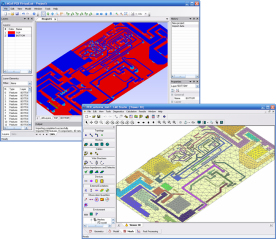EMC Studio v6.0 available
New Features and Improvements in Matrix Partition Solution
EMC Studio 6.0 provides improved Matrix Partitioning calculation scheme. This includes:
- Improvement of calculation scheme: less HD space required, easier parallel cluster calculations
- Optimized task processing: one input file definition for set of problems, one execution of computational solver
- Improvements in Layers organization for geometry objects
- Layer Sets for convenient definition of calculation task and separate view of each model variation

Detection of Geometry Elements Related to Dielectric Substrate
For correct simulations of glass antenna optimization problems using Matrix Partitioning scheme all metallic elements affected by dielectric substrate must be placed to the same Base Layer or Additional Layers Set as dielectric. New geometry selection tool provides fast and convenient access to triangles and wire segments related to particular dielectric substrate.

New Features and Improvements in Multi Excitation Solution
EMC Studio 6.0 provides improved Multi Excitation calculation scheme. This includes:
- Improvement of calculation scheme: less HD space required, easier parallel cluster calculations
- Optimized task processing: one input file definition for set of problems, one execution of computational solver
- Excitation Sets allows to group several excitation sources for convenient definition of calculation task

New Ideology of S, Y, Z Solution – Multiport Solution
EMC Studio 6.0 provides new ideology of Multiport solution. This includes:
- Easier calculation approach for analysis of multiport systems
- User-defined reference impedance
- User-defined type of output network parameters (S, Z or Y)
- New Port objects are introduced in TriD solver
- Antenna diversity analysis by means of Correlation Coefficient
- New 2D Post Processing Tool for Correlation Coefficient observation

Near Field Calculation in Volume – Near Field Grid
EMC Studio 6.0 provides new observation quantity, Near Field Grid required for near field calculation and observation in volume. In this case field values are calculated in vertices of the defined near field grid.

Field Reference Level – Iso-line and Iso-surface Definition
EMC Studio 6.0 provides new field reference levels visualization options for convenient analysis of smart entry antenna systems – Iso-line and Iso-surface modes.

LF Magnetic Field Analysis Type for Low Frequency Problems
New LF Magnetic Field Analysis Type in EMC Studio 6.0 provides numerical modeling of low frequency magnetic fields interaction with thin 3D sheets characterized by combined resistive and magnetic properties. Automotive and industrial magnetic shielding problems can be effectively solved in frequency range from DC up to several MHz.

Extension of Shield Shapes
EMC Studio 6.0 provides extended functionality for cable shields in Hybrid Analysis Type:
- Shielded Ribbon Cables Support
- Outer Covering Support for Coaxial, Ribbon and Multi Cables
- Wrap Shaped Shields Support for Multi Cables

IBIS Devices Support
IBIS is the Input/Output Buffer Information Specification from the Electronics Industry Alliance. IBIS is a behavioral model that describes the electrical characteristics of the digital inputs and outputs of a ECU through V/I and V/T data without providing the actual circuit information. An IBIS model consists of tabular data made up of current and voltage values in the output and input pins, as well as the voltage and time relationship at the output pins under rising or falling switching conditions. This tabulated data represents the behavior of the ECU.
In order to introduce ECU behavioral characteristics to system simulation model EMC Studio 6.0 provides new type of deviceВ – IBIS Device.

Support of Bits Sequence Sources an Eye Pattern Diagram
EMC Studio 6.0 supports special type of sources in Schematic Elements Library, intended for bit signal generation in time domain tasks – Bits Sequence Sources. This includes:
- Pseudo Random Bits Sequence
- Random Bits Sequence
- Static Bits Sequence

PCB Modeling in Complex Environment
Comming soon powerful navigator and pre-processor for printed circuit board systems EMCoS PCB VirtualLab in conjuction with EMC Studio 6.0 provides full tool chain for PCB models integration into complex environment and simulation. Modeling workflow consists of the following steps:
- Importing of PCB model in ODB++ file format to EMCoS PCB VirtualLab
- Pre processing and assignment of physical parameters using EMCoS PCB VirtualLab tools
- Converting of PCB to EMC model compatible with EMC Studio
- Importing of PCB model to EMC Studio project
- Construction of complete simulation task for analysis in EMC Studio environment

More Features
- New 2D Post Processing Tool for Antenna Correlation Coefficient Observation
- Improved Wires Routing in System Diagram
- User – defined Probes for Circuit File Devices
- ASC File Format Extension
- Improved Intersection Detection between Cables and Triangles
- New Segments Grouping Functionality – Cable Routes
- Extension of Object/Model Ideology to Hybrid Analysis Types
- Near Field Distribution in Near Field Grid
- Dielectric Substrates Support in LF Electric Field Analysis Type
- Extension of Models Library with Virtual Bench Models
- Full Support of Windows 7 Operating System
Enhancements
- Faster LC Calculation with LF Electric Field Solver
- Improved Construction of Cable Bundle Cross-section
- Support of Binary Format for TriD Output File
- Improved Output File for Time Domain TriD Calculations
- Definition of Multiple Calculations for Stochastic Cables Analysis in XTalk and Radiation Hybrid Solvers
- Slight Improvements in S2Cir Converter
- Support of Multiple Near Field Sources and Impressed Currents
- Improvement of Cables Auto-bundling for Random Type
- Improved Cables Library
- Improved Processing of Imported Touchstone and From File Devices
- View Indexes of Circuit Element Pins in Schematic
- Convenient Selection of Splices
- Improved Union Segments Functionality
- Convenient Handling of Near Field Areas in 3D Post Processing
- Improved 2D Post Processing for Near Field Observations
- Possibility to Edit Input File for Hybrid Analysis Type for Advanced Users
- Improvement of Static2D Viewer
- Improvement of Static2D Viewer

